xdt rdby
resrv
xdt rdby
resrv
dsfdrtrd
028802880288028802880288
sfse
sds
dgfg
Congratulations on your huge Olympic success. Has it sunk in yet?
No, it hasn’t! It still feels a bit weird. I haven’t been back in the UK long and it’s been quite busy – but it’s good. It will take a long time to really sink in.
You won two golds in about an hour: first on the floor where you weren’t among the favourites, and then on the pommel horse where you were. Were you worried that the surprise win would cost you in your strongest event?
No. I just had to forget about it. I still had a job to do.
Wait, you just forgot that you’d won a gold medal?!
Yes [laughs] – obviously that was really, really hard to do! My aim was to make the Olympic floor final, because that would have been a first for me, and I thought it would help me ease myself in for my strongest event, the pommel. So making the floor final was a huge bonus, and to then win the gold – it hit me hard. But I had 30 minutes to get back to the training gym and block everything out of my head, because I still had one more job to do.
When did you realise you’d won that first gold?
I saw my score and that I’d gone into first place, but to be totally honest I didn’t know what was going on. My team-mates and coaches were saying, “Max, do you want to know what soand-so just scored?” and I was begging them not to tell me! Then after the last guy went and made a slight mistake my coach nudged me and told me I was an Olympic champion.
Did you know you’d done enough on the pommel to win the second gold?
I got off and thought I’d done well, but I had no idea how Louis [Smith, Whitlock’s team-mate whom he beat into second place] had done, or anyone else who had gone before me. From a young age I’ve never watched any rival gymnasts perform when competing. All I can do is focus on my job of performing to the best of my ability, and I was happy because I’d done my job and got through my routine clean. I knew that if I did that I stood a good chance.
How did you cope with such intense pressure?
It was completely different to London 2012 because I was the young kid who wasn’t expected to do much. Rio was different. I felt like I had to deliver and the whole team were expected to come back with medals. So there was pressure and I was nervous, but I blocked that out. I’ve been training for years to deliver in critical moments, and all my hard training paid off.
Where do you get confidence from? A successful training camp?
Absolutely. That’s vital for me. If I have a good build-up before a competition then that really takes the pressure off. If you know deep down that there’s nothing more you could have done it gives you confidence that you’re ready. My build-up for Rio was great and I arrived feeling good, without any niggles, and my confidence was high.
Is training a case of practice makes perfect?
Yeah, it’s about muscle memory and putting in the hours until it becomes completely natural. I even practice making mistakes on purpose so that if it does happen, my muscle memory kicks in and I can get out of trouble straight away. Take the pommel: ideally you want the routine to be straight legs and pointed toes with a clean dismount. But I’ll do a routine scruffy, with bent legs, so I know what to do if that happens when it matters.
How you bounce back from competition disappointment?
You have to learn from the mistakes. There have been competitions where I haven’t done as well as I wanted and these are the times that I learned the most. You have to find a positive from every setback. You have to look deep inside yourself and when you do it moves you forward.
Max Whitlock is a Myprotein ambassador. Visit myprotein.com
Some people claim it’s impossible to burn body fat and burn muscle at the same time, believing that you have to prioritise one training goal over the other. That’s not the case – but to achieve both simultaneously, you have to start training smarter. This month’s main workout will get you doing just that because each week it combines two total-body sessions, taxing all your muscles to initiate the fat-burning process, with two upper-body muscle-building sessions, which will add lean mass across your torso. The result is that you will transform your physique by stripping away unwanted fat from across your middle while sculpting a bigger, stronger body.
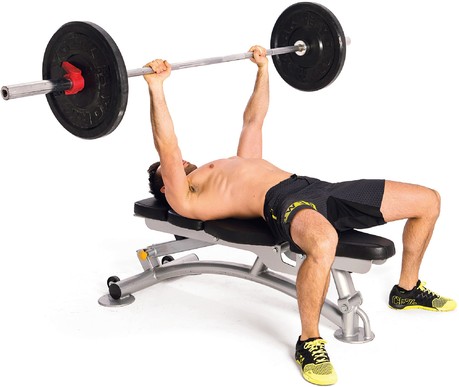
Photography Tom Miles, Glen Burrows Models Greg Cornthwaite, Daniel Ventura
HERE’S HOW THE PLAN WORKS
This month’s four-week workout is made up of four sessions a week. Workout one is a total-body session; workout two targets your chest and back; workout three is another total-body session; and workout four hits your arms and shoulders. This approach gives you the fat-burning benefits of two tough full-body workouts per week and the muscle-building benefits of also hitting the major muscles of your upper body with their own dedicated session.
Each workout is made up of five moves. The first two moves are big, compound lifts done in a superset for four sets of 12 reps to get your heart rate high and muscles pumped. The final three moves make up a tri-set, which means you’ll do them in order with minimal rest until you’ve completed all the reps of the third move. Do the workouts in order, sticking to the sets, reps, tempo and rest periods detailed, and you’ll blast away your belly fat while also adding lean muscle mass to your chest, arms, shoulders and back, giving you your best ever body after just four weeks.
TEMPO TRAINING
To get the full effect from these workouts, you need to stick to the four-digit tempo code for each exercise. The first digit indicates how long in seconds you take to lower the weight, the second how long you pause at the bottom of the move, the third how long you take to lift the weight, and the final digit how long you pause at the top. The accumulated time under tension increases your heart rate to burn body fat and break down muscle tissue so it’s rebuilt bigger and stronger. Keep each rep smooth and controlled so your muscles – not momentum – do the work, and move through a full range of motion.
Here’s how each week of the plan is structured

Workout 1
TOTAL BODY
1A SQUAT
Sets 4 Reps 12
Tempo 2010 Rest 30sec
Stand tall with a bar across the backs of your shoulders. Keeping your chest up and core braced, squat down as deep as you can. Drive back up through your heels to return to the start.

1B TRICEPS DIP
Sets 4 Reps 12
Tempo 2010 Rest 60sec
Grip rings or parallel bars with your arms straight. Keeping your chest up, bend your elbows to lower your body as far as your shoulders allow. Press back up powerfully to return to the start.

2A GLUTE BRIDGE
Sets 4 Reps 12
Tempo 2111 Rest 10sec
Lie with your upper back supported on a bench, holding a barbell across the tops of your thighs. Thrust your hips up, squeeze your glutes at the top, and then return to the start.

2B INCLINE DUMBBELL CURL
Sets 4 Reps 12
Tempo 2111 Rest 10sec
Sit on a bench angled at 45° with dumbbells by your sides, palms facing forwards. Keeping your elbows tucked in, curl the weights up, squeezing your biceps at the top. Lower them back to the start.

2C SEATED OVERHEAD PRESS
Sets 4 Reps 12
Tempo 2010 Rest 60sec
Sit on an upright bench with a dumbbell in each hand at shoulder height. Keeping your chest up, press the weights directly overhead until your arms are straight, then lower them back to the start.

Workout 2
CHEST AND BACK
1A BENCH PRESS
Sets 4 Reps 12
Tempo 2010 Rest 30sec
Lie on a flat bench holding a barbell with your hands slightly wider than shoulder-width apart. Brace your core, then lower the bar towards your chest. Press it back up to the start.

1B BENT-OVER ROW
Sets 4 Reps 12
Tempo 2010 Rest 60sec
Hold a barbell with an overhand grip, hands just outside your legs. Hinge forwards from your hips, brace your core, then pull the bar up, leading with your elbows. Lower it back to the start.
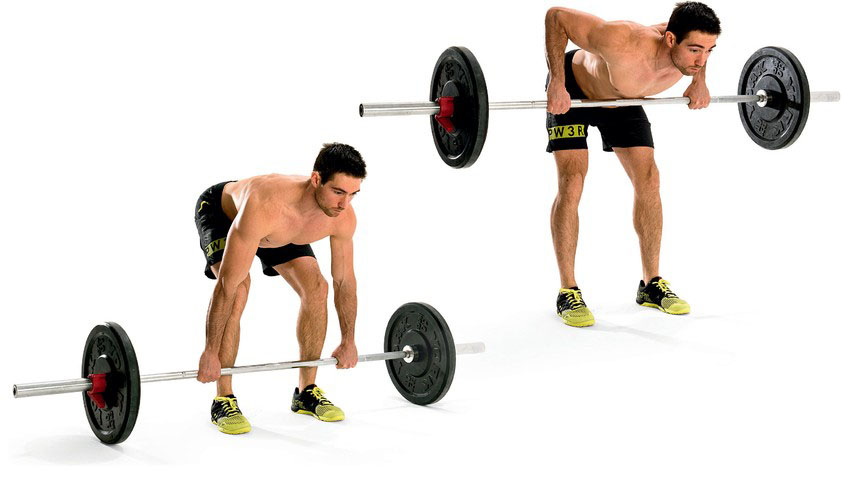
2A INCLINE DUMBBELL PRESS
Sets 4 Reps 12
Tempo 2010 Rest 10sec
Lie on an incline bench holding a dumbbell in each hand by your shoulders. Brace your core, then press the weights up until your arms are straight. Lower them back to the start.

2B INCLINE DUMBBELL FLYE
Sets 4 Reps 12
Tempo 2010 Rest 10sec
Lie on an incline bench holding a dumbbell in each hand above your face, with your palms facing and a slight bend in your elbows. Lower them to the sides, then bring them back to the top.

2C ONE-ARM ROW
Sets 4 Reps 12 each side
Tempo 2111 Rest 60sec
Kneel on a bench with one hand on it for support, holding a dumbbell in the other hand. Keeping your chest up, row the weight up, leading with your elbow, then lower back to the start. Complete all the reps on one side, then switch.

Workout 3
TOTAL BODY
1A FRONT SQUAT
Sets 4 Reps 12
Tempo 2010 Rest 30sec
Stand tall with a bar across the front of your shoulders with elbows up. Keeping your core braced, squat down as deep as you can. Drive back up through your heels to return to the start.

1B RACK PULL
Sets 4 Reps 12
Tempo 2010 Rest 60sec
Stand tall in front of a barbell resting on safety bars at knee height. Using a double overhand grip, bend down and deadlift the bar up, squeezing your shoulder blades together at the top.

2A GOOD MORNING
Sets 4 Reps 12
Tempo 2111 Rest 10sec
Stand tall holding a light barbell across the backs of your shoulders, feet shoulder-width apart. With your core braced, bend forward slowly from the hips, as far as your hamstrings allow but not past horizontal. Return to the start.

2B REVERSE FLYE
Sets 4 Reps 12
Tempo 2010 Rest 10sec
Bend forward from the hips with a light dumbbell in each hand with palms facing. Keeping a slight bend in your elbows, raise the weights out to shoulder height, then lower back to the start.

2C BARBELL ROLL-OUT
Sets 4 Reps 12
Tempo 2111 Rest 60sec
Kneel on the floor holding a barbell with both hands. Roll the bar forward so you lower your torso, keeping your core braced. Then use your abs muscles to return to the start.

Workout 4
ARMS AND SHOULDERS
1A CHIN-UP
Sets 4 Reps 12
Tempo 2010 Rest 30sec
Hold a bar with an underhand grip. Brace your core, then pull yourself up until your chin is higher than the bar. Lower until your arms are straight again.
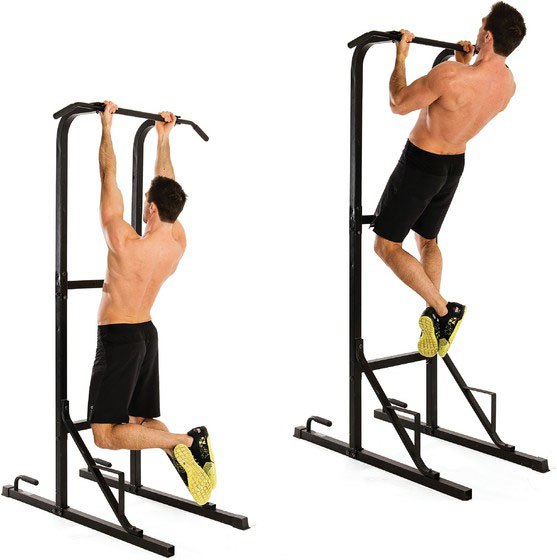
1B OVERHEAD PRESS
Sets 4 Reps 12
Tempo 2010 Rest 60sec
Hold a barbell across the top of your chest with your hands slightly wider than shoulder-width apart. Keeping your chest up and core braced, press the bar overhead until your arms are straight. Lower it back to the start.

2A STANDING DUMBBELL BICEPS CURL
Sets 4 Reps 12
Tempo 2010 Rest 10sec
Stand with dumbbells by your sides, palms facing forwards. Keeping your elbows tucked in, curl the weights up, squeezing your biceps at the top. Lower them back to the start.
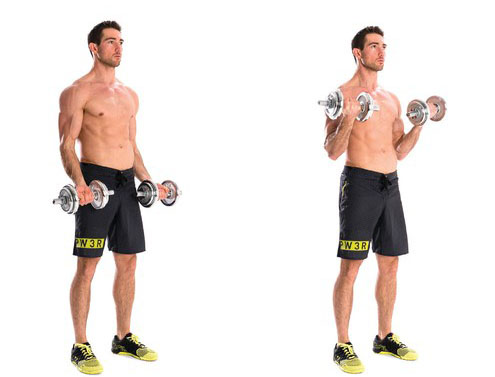
2B TRICEPS EXTENSION
Sets 4 Reps 12
Tempo 2111 Rest 10sec
Stand tall holding a dumbbell over your head with both hands, arms straight. Keeping your chest up, lower the weight behind your head, then raise it back to the start.
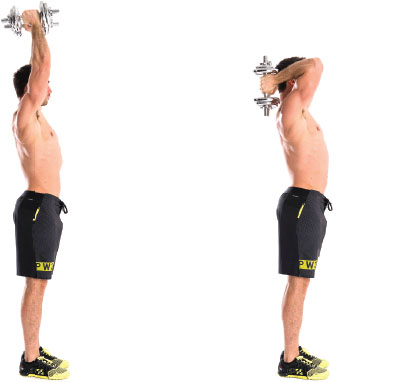
2C LATERAL RAISE
Sets 4 Reps 12
Tempo 2111 Rest 60sec
Stand tall, holding a light dumbbell in each hand with palms facing. Keeping your chest up and a bend in your elbows, raise the weights out to shoulder height, then lower back to the start.

When you think of explosive power, your first thought is likely of sprinters or strongmen who need to move a weight (or themselves) from point A to point B as quickly as they can. But building explosive power won’t just make you faster or stronger, it will also help you build more lean muscle mass in less time. That’s because the quicker and harder you can contract a muscle, the more weight you can lift, and the more tension you can place upon it both during the concentric (lifting) part of a rep as well as the eccentric (lowering) part too. Fortunately, improving your explosiveness is simple. Try this five-move workout that requires just one bit of kit – a medicine ball – to fire up your muscles and build the explosive speed and power that will transform your training and performance, as well as your physique.
Pick a med ball at a weight that allows you to perform all the exercises explosively – the main aim here is to develop speed
POWER UP
This workout has five moves. The first four moves are paired in supersets. Do all five reps of move 1A, rest for 10sec, then do all five reps of 1B, then rest for 60sec. Repeat this for five sets, then move on to moves 2A and 2B and follow the same pattern.
The final move is performed as a straight set. Focus on keeping your abs, lower back and glutes engaged for every rep of every set to keep your body stable and improve power transfer between your upper and lower body.





Keep your heels off the floor for the duration of the set to keep your lower abs engaged and work your muscles harder
Enter the FitBrit Challenge today and get your FREE 3-day Fitness First gym pass at fitnessfirst.co.uk/fitbrit
START STRONG
The best way to warm up for the FitBrit Challenge, and your training sessions before it, is to get your pulse raised and test yourself on each exercise. It’s important to keep your warm-ups specific to the task in hand. So once you’ve got your heart rate up on the treadmill, bike or rower, perform the challenge’s resistance moves with around 40-50% of the weight for half the reps. This will keep your pulse up, as well as preparing both your mind and your muscles so you’re ready to start strong.
UP THE EFFORT
To ensure you give yourself the best odds of setting a red-hot time, practise doing the full challenge but halving the reps for the resistance moves and halving the distances for the cardio parts. This will allow you to go all-out for the duration of the session to build speed and stamina. Next time, do 75% for each part of the event. Not only will this help you perform physically, but it will also give you confidence and belief in your ability.
PACE YOURSELF
The biggest mistake people make when trying to set a good FitBrit time is setting off too fast. It’s tempting to hit the 800m run hard – because it’s the first exercise, you start it feeling strong and fresh. But going too hard too soon will empty your tank. Start at 70% of the effort you’d normally exert for 800m, then perform the next three moves (30 24kg kettlebell swings, 20 20kg ViPR tilts and 10 burpee box jumps) at a steady pace. Then you can really push hard on the 1.5km bike – this is where you can make up the most time, so focus on a high RPM to eat up the clock.
USE YOUR HEAD
Ask anyone who has ever completed the FitBrit Challenge and they will tell you how tough they found it. Not just physically, but also mentally. Even though you’re likely to be doing it in the middle of a busy gym, you’ve got to stay focused on what you’re doing and not allow mental fatigue to set it. Stick to your plan and concentrate only on the event at hand. Thinking about the next event or how much you still have to do before the finish will only harm your chances of setting a new best time.
FINISH FAST
Once you get off the bike, you have three resistance exercises to get done quickly: 10 parallette shooters, 20 20kg kettlebell sumo deadlift to high pull and 30 7kg sandbell rainbow slams. These are tough, especially after a hard ride, but it’s a good idea to keep each move fast but consistent to get to the final event – the 500m row – in good shape. The row is your opportunity to empty your tank and really go for your best possible time. Leave nothing on the gym floor – this is where you can make or break your FitBrit Challenge.
Bodyweight moves are great for developing a foundation of abdominal size and strength – but if you want to sculpt a rock-solid six-pack, you’ll need to start adding resistance. One of the most effective tools for the job is a kettlebell. “I use kettlebells for abs moves because they’re versatile,” says Ashton Turner from London’s Evolve 353 gym. “Single-sided moves make you unbalanced so your body has to work harder to keep you stable. Any overhead move, like a windmill, will also require good core strength to stabilise your spine.”
HOW TO DO IT
Do three sets of ten reps for each exercise, resting for 45 seconds between sets and 90 seconds between exercises. For single-sided exercises such as the side press, do two sets on each side, alternating sides each set. To keep progressing, add a rep to every set each time you train, until you’re doing 15 reps in each set. After that, use a heavier kettlebell and go back to doing ten reps.
WHY IT WORKS
The moves in this workout will help you develop your anti-rotation abilities, which enable you to resist being pulled out of position. “It’s one thing to train rotational strength but you need to control anti-rotation first,” Turner says. They will also give you a comprehensive abs and core workout, targeting your rectus abdominis (the sheet of muscle that makes up your six-pack), side abs and lower back.

MEET THE EXPERT
Ashton Turner is the co-founder of Evolve 353 gym in London (evolve353.com).
He has worked with clients across multiple training disciplines including kettlebells, Olympic lifting, strength and conditioning and Pilates.

1 ROLLING THUNDER
HOW Lie on your back and hold a kettlebell in each hand by your chest. Straighten one arm and push upwards so your shoulder leaves the floor and you twist your torso. As you lower that kettlebell, extend the other arm to create a smooth rhythm.
EXPERT TIP “Lying on the floor reduces the instability, and therefore the risk, of the exercise,” says Turner. “I get people to think about imprinting their lower back on the floor. That will help you to avoid overarching your lower back and switching off your abdominal muscles.”

2 WINDMILL
HOW Start with the weight above your head and your feet wider than shoulder-width apart. Your weight distribution should be biased towards the side that’s holding the bell. Look at the bell and, keeping your eyes on it, lower your torso until your hand touches the floor.
EXPERT TIP “Windmills look intimidating but they are an excellent move for building core stability and shoulder stability because they require a lot of control,” says Turner. “They also give you a good hamstring stretch.”

“Always look at the kettlebell throughout the move,” says Turner. “That will help you stay stable and avoid putting too much stress on your shoulder joint”
3 SIDE PRESS
HOW Start with the kettlebell at shoulder height. Brace your core and lower your torso to one side while simultaneously straightening your arm. Aim to keep the kettlebell in place so that it barely moves – instead, your body should move away from it. From there, reverse the move back to the start.
EXPERT TIP “This is a great obliques – side abs – exercise because you have to stabilise your torso as you push the weight away from your body,” says Turner. “As you get lower, the intensity of the exercise increases and your centre of mass changes. That forces you to think about the constantly changing kettlebell movement and instability as you go through the exercise.”
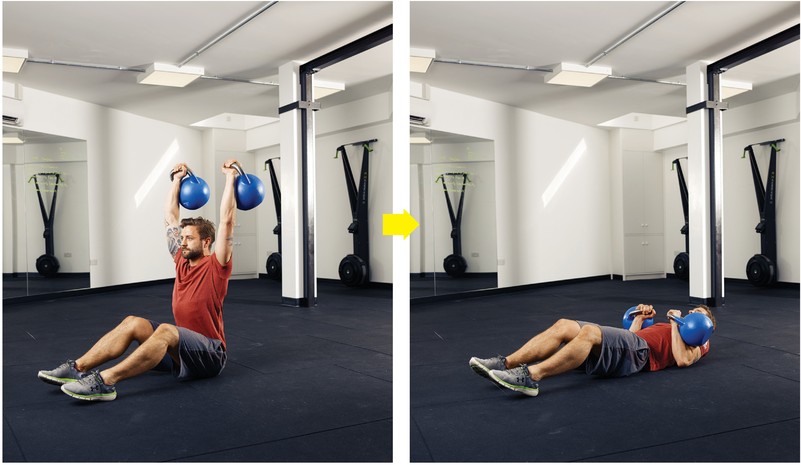
4 ANGEL PRESS
HOW Start by sitting down with your knees bent, holding two kettlebells overhead. Slowly lower towards the floor while bringing the kettlebells down to your chest. Contract your abs to raise your torso while simultaneously extending your arms.
EXPERT TIP “Once you’re sitting up straight, tuck your pelvis under and, as you lower, ‘roll through’ your spine so you’re trying to make contact with the ground one vertebra at a time,’ says Turner. “Going slowly on this move will make your abs work harder.”

5 PLANK DRAG
HOW Get into a straight-arm plank position with your body in a straight line from head to heels, with a kettlebell positioned on one side of your body. Reach under your torso to drag the bell across to the other side. Switch hands and repeat the move.
EXPERT TIP “This is great way of making the plank more interesting,” says Turner. “The wider you take the kettlebell, the hard it is to do. You can also try raising the kettlebell off the floor slightly to turn it into a modified reverse flye.”